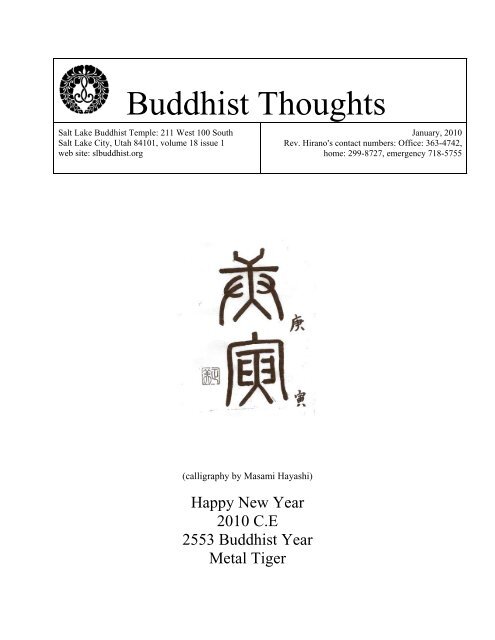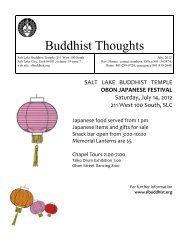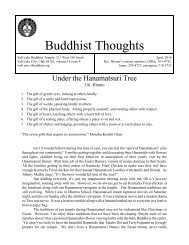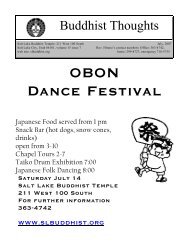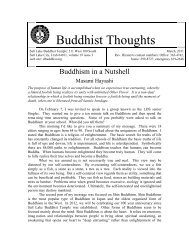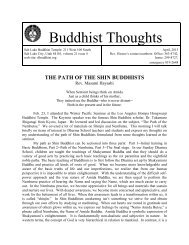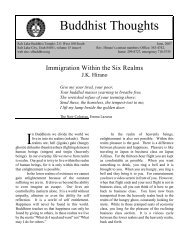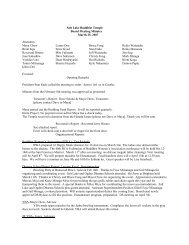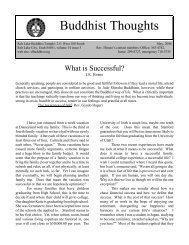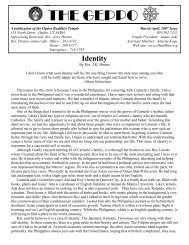Buddhist Thoughts - Salt Lake Buddhist Temple
Buddhist Thoughts - Salt Lake Buddhist Temple
Buddhist Thoughts - Salt Lake Buddhist Temple
Create successful ePaper yourself
Turn your PDF publications into a flip-book with our unique Google optimized e-Paper software.
<strong>Buddhist</strong> <strong>Thoughts</strong><strong>Salt</strong> <strong>Lake</strong> <strong>Buddhist</strong> <strong>Temple</strong>: 211 West 100 South<strong>Salt</strong> <strong>Lake</strong> City, Utah 84101, volume 18 issue 1web site: slbuddhist.orgJanuary, 2010Rev. Hirano=s contact numbers: Office: 363-4742,home: 299-8727, emergency 718-5755(calligraphy by Masami Hayashi)Happy New Year2010 C.E2553 <strong>Buddhist</strong> YearMetal Tiger
THE VIEW FROM OUTSIDE IN:The 4 th Overseas District Representatives Seminar at theHongwanjiCarmela Javellana Hirano. M.D.“How was Japan? Did you have a good time?”Quite a few people came up to me shortly after Jerry and I came back October 17, 2009,asking about the trip. How can I summarize such an amazing, profound experience? How can Igive justice using words to what brings awe and spiritual inspiration to millions of Jodo Shinshu<strong>Buddhist</strong>s in Japan, and many more throughout the world? And how can I express gratitude toBCA and Nishi Hongwanji for allowing me this opportunity to see for myself the legacy ofShinran?The sights and sounds of Tokyo told me I was in a country of rich heritage and cuttingedge technology. Although I felt like an idiotic illiterate, not being able to read, say, orunderstand anything in Japanese, I sensed the considerate gentleness of the Japanese people, asthey spoke softly and melodiously, and bowed to each other and to us at every opportunity.Underneath this courteousness seemed a quiet determination to fulfill their day’s purpose, as theybustled on the busy narrow streets in their bicycles and efficient little cars, some parked cleverlyto fit in tidy little garages in front of nifty little houses. I savored tonkatsu, ramen, takoyaki, anddelicious sushi I’d never seen before with gusto. I especially loved the roofs – only in Japanhave I seen slate dressed in organic colors in gassho.After the bullet train showed me the countryside, Mount Fuji suspended in clouds, andlittle villages here and there, we came to Kyoto. It seemed unhurried and laid back, unlike thesuffocatingly crowded streets at Harajuku, famed in the US for its funky fashion in clothes andaccessories. Finally we came to Nishi Hongwanji – in contrast to the rest of the city, it wasimmense and overpowering. I was looking at the face of centuries of tradition, in it embeddedthe essence of Shinran and his work in teaching the dharma. We even got to meet the Gomonshuhimself, and the highest ranking officials of the organization, first during the opening service,then at a very nice dinner just for us “foreigners.” I hope it won’t be the last we discuss conceptslike “mottai nai” with Gomonshu-sama, thanks to the interpreting skills of Tanaka Sensei andArai Sensei.We had 3 days of touring Hongwanji, and studying and discussing issues regardingBuddhism in America and Canada, under the lively and provocative instruction of Rev. Dr. KenTanaka and Professor Toshikazu Arai. Arai Sensei taught the Essentials of Jodo Shinshu, theorganizational structure of Nishi Hongwanji, and the “Overseas” role of BCA and BCC. TanakaSensei lectured on the Growth of Buddhism in America. In my mind I concluded that BCA andBCC seem like toddlers trying keep going on a bike with no training wheels in the woods. Wediscussed “American Buddhism” and how its identity is not clearly understood, because peoplewho call themselves <strong>Buddhist</strong>s may not be <strong>Buddhist</strong> at all (as Tanaka Sensei referred to some as“Nightstand <strong>Buddhist</strong>s” and “sympathizers”), and people who do not identify themselves as<strong>Buddhist</strong> have <strong>Buddhist</strong> views about life and death. There are traditional Asian <strong>Buddhist</strong>s, newAsian American <strong>Buddhist</strong>s, and non-Asian <strong>Buddhist</strong> converts who either concentrate onmeditation and mindfulness or chanting.Questions were raised regarding the place of Jodo Shinshu Buddhism in America. It
seems to me that so far, there has not been much literature or discussion about our sect inmainstream “New Age America,” this spiritual movement of seekers who have put some seriousstudy on ancient teachings and integrating them into contemporary lifestyles. I love going tobookstores like Barnes and Noble, and the sections on spirituality or Buddhism have noselections on Jodo Shinshu among the myriad of works by Zen and Tibetan authors. There hasgot to be a place on those shelves for the Gomonshu’s book “The Buddha’s Wish for the World.”“Why is that?” I asked myself, listening further to the discussion. (I had suggested to theGomonshu that he needs to be more well-known and popular in America, and maybe writeanother book with a provocative title, either “The Power of the Fool” as suggested by theGovernor General).The declining membership in the US is currently a challenge, despite the overall growthof Buddhism in America. I’m not sure if anybody else in the group had any answers either.Most had the same dilemma in their own sanghas. (I would offer a hypothesis at this point, andthat is, the Japanese sentiment of enryo – holding back – may keep Jodo Shinshu teaching frombeing more accessible to mainstream America.) How can the Dharma pill of hardcore JodoShinshu be swallowed unless it were sugar-coated with American consumerism?We explored ways of improving our sangha memberships. We discussed <strong>Temple</strong>-basedactivities: bazaars, bingo, boutiques, basketball, and all the buzz about the above. We explored“individually-focused enlightenment”, one person at a time. I suppose any of these could work.In examining my own path of conversion from hard-core Roman Catholicism to Zen, then JodoShinshu Buddhism, it seems it wasn’t due to any of my own self-power that brought me here. Itwas Other Power, the pure grace from Amida Buddha. There were many individuals who cameinto my life and touched me in subtle and profound ways – friends, authors, teachers, myhusband, my family, even strangers – and now Gomonshu-Sama himself. It is not very often onereceives the honor of dining and discussing teachings with the 24 th Head of our sect. GettingJodo Shinshu out there out there to others, I thought, requires making a shift in viewpoint:looking in rather than looking out. I have been a lucky recipient of Shinran’s teachings. I havebeen given this amazing opportunity to visit Japan and see Hongwanji in concrete reality.Being Filipino American, I have no sense of enryo – which is probably why I felt no inhibitionsat the dinner table with the Gomonshu and the Governor General as soon as they were seated. Itis my responsibility now, out of gratitude, and NO ENRYO for me, to pass this gift to others.Arai Sensei aptly said: “Each person is proof of the working of Amida’s Vow.” This being thecase, then there is no need for worry or concern. Perhaps all that needs to be done, whether inparenting, volunteering, working, texting, grocery shopping, or discussing, is to connect withother human beings and try to live the dharma with sincerity, authenticity and appreciation.Looking in, I connect with myself. Looking out, I connect with others.I am deeply grateful for this opportunity to represent the BCA and experience thegenerosity and support of Nishi Hongwanji. Namo Amida Butsu.President’s MessageDot RichedaOn Dec 10, 2009 the <strong>Temple</strong> Board meeting was held and the results of the <strong>Temple</strong> Boardelection and <strong>Temple</strong> Officers resulted in the following:
NEW BOARD MEMBERS FOR 2010-2011Maya Chow, Phillip Sakashita, Reiko Watanabe, Brent Koga, Karie Minaga Miya, Brenda Koga,Paul Terashima, Troy Watanabe, Christy Fong, Jane Sakashita, Sherri Hayashi, Karen Seo.BOARD MEMBERS FOR 2010Dave Sekino, Stan Endo, Tomio Mitsunaga, Jeff Watanabe, Ernie Kyed, Bruce Fong, MarkMinaga, Jim Eng, Reiko Mitsunaga, Kathy Terashima, Reiko Matsuura, Dot Richeda, DeanHirabayashi.<strong>Temple</strong> Officers:President: Dot RichedaVice Presidents: Ivan Van Laningham, Bruce FongCorresp Sec: Reiko MitsunagaRecording Sec: Karen TohinakaTresurers: Maya Chow, Dave SekinoAuditors: Reiko Watanabe, Reiko MatsuuraI would like to thank everyone for their support and hard work for the temple. We look forwardto 2010.The <strong>Temple</strong> General Meeting will be held on January 31, 2010. Please attend this mostimportant meeting.TOBAN assignments for the first two months of 2010 are as follows:JanuaryDavid SekinoMike ToninakaChuck ChowBruce FongWes KogaBrenda KogaKaren TohinakaMaya ChowChristy FongDebbie KogaFebruaryStan EndoElaine EndoRick SpeharMarcus MiyaDave NagataRon OmoriMark MinagaGail MinagaSusan SpeharKarie Minaga MiyaJulia NagataLinda Omori
STATE OF THE BWAJane SakashitaAThe smallest effort is not lost,Each wavelet on the ocean tossedAids in the ebb-tide or the flow.@This was written by Charles Mackay in the 1800's. As I remembered this quote, Ithought of the many BWA members who have come to the temple and helped in numerousways.....some perhaps in a very small way but, nonetheless, all of you have helped in the flow ofour temple.We have about sixty paid-up members who aided us throughout this year. As I reviewthe various activities held during the year, I am most grateful for the tremendous hours, minutesand seconds of time that you expended.* Hoonko luncheon for which the BWA provided salads, side dishes and desserts.* The Omigaki (polishing of the altar pieces) took place in March.* Hanamatsuri luncheon for which Onigiri and Sakura Manju were prepared.* Gotan-e workshop and service were very well attended.* In June, Eshinni-ko service during which new members were recognized and aluncheon held at the J. Wong Asian Bistro. A BWA seminar was held prior to theservice.* The Obon food preparation took many hands since this was the main public event thisyear due to our temple renovation.* In August we took a bus trip to and from Las Vegas to participate in their ObonFestival. We welcomed the exchange students from Japan at a Pagoda dinner. Theannual steak fry picnic at Sugarhouse Park was overflowing with various food items.* Great <strong>Salt</strong> <strong>Lake</strong> Chili Affair was volunteered by our members.* Luncheon was hosted by the <strong>Salt</strong> <strong>Lake</strong> BWA at the Mountain States DistrictConference held in Ogden in September.* National BWA Conference held in Sacramento in October was attended by tworepresentatives as well as by the Mountain States District BWA president of <strong>Salt</strong> <strong>Lake</strong>.* Many were involved in restoring the altar pieces and organizing the kitchen items inthe renovated temple. A special recognition to Ernie Kyed and Brenda Koga forspearheading and helping us to accomplish the beautifully remodeled temple.* Bodhi Day luncheon salads, desserts and side dishes were provided by the BWA.* In addition, the public relations conducted during the year brought comfort as well ashappiness to <strong>Buddhist</strong> <strong>Temple</strong> members and their families.My compliments to all the BWA board, officers and members. I appreciate your support andcooperation from the depth of my heart. Thank you for making 2009 a memorable one, and Ilook forward to the New Year by practicing words from a 1983 <strong>Buddhist</strong> calendar.With Gratitude, with Humility and with Openness of Heart.
to take part and to conduct the Kieshiki ceremony. Those who would like to receive their<strong>Buddhist</strong> name should fill out the application form and return it to Rev. Hirano by February 1.The following is information sent out by BCA concerning the ceremony’s meaning.The Meaning of the CeremonyIn this Shin <strong>Buddhist</strong> ceremony, performed before the altar of Amida Buddha andShinran Shonin by the Bishop (Socho) of the BCA, one takes the important step of affirmingone’s reverence for the Buddha, Dharma, and Sangha, and one’s determination to tread the pathto Buddhahood. When the ceremony is conducted by the Monshu, spiritual head of the JodoShinshu Hongwanji-ha denomination, the ceremony is referred to as the Kikyoshiki ConfirmationCeremony.The Three Refuges in General <strong>Buddhist</strong> TraditionIn the time of Shakyamuni Buddha, one was permitted to join the <strong>Buddhist</strong> community(sangha) upon receiving the precept of the three refuges under the guidance of a monk andshaving one’s head.To receive the precept of the three refuges means to declare before one’s teacher that onetakes wholehearted refuge in the Buddha, Dharma, and Sangha, and to vow that one will notdeviate from them.“Buddha” here refers to Sakyamuni, “Dharma” to Sakyamuni’s Teaching, and “Sangha”to the community of followers who have entrusted themselves to Sakyamuni Buddha’s teaching.Because these form the basis of what one values most in one’s life, they are called the “threetreasures.”Shaving one’s head symbolizes departure from the worldly ways of life and entrance intoa life devoted to the path of Buddhism, which transcends the mundane world.The Affirmation CeremonyThe teachings of Sakyamuni Buddha are so extensive that they are said to number84,000. It is no surprise, then, that after the Buddha’s death, various schools developed based onthe different aspects of his teachings. Shin Buddhism (Jodo Shinshu) is the <strong>Buddhist</strong> path ofgreat compassion clarified by Shinran Shonin. Shinran teaches that Sakyamuni appeared in thisworld in order to reveal the Vow of Amida Buddha to save all beings; it is the salvation of allpeople by Amida Buddha that is Sakyamuni’s fundamental teaching.The Affirmation Ceremony in Shin Buddhism, therefore, shares a common meaning withthe precept of the three refuges administered in the time of Sakyamuni Buddha, but it also has aspecial meaning. In the Affirmation Ceremony, the Buddha of the three refuges is not simplySakyamuni, but refers especially to Amida Buddha, who is the heart of Sakyamuni’s teachings.Sakyamuni came into the world to teach the Vow of Amida Buddha, and our salvation is broughtabout by Amida. Thus, “Dharma” is the teaching of Amida’s compassionate working to save allbeings, and “Sangha” refers to people who have entrusted themselves to Amida.Since there are no precepts in Shin Buddhism, instead of receiving the precept of thethree treasures, one participates in the Affirmation Ceremony.
Also, Shin practicers do not shave their heads, but undergo a ritual and symbolic shavingwhich has similar meaning. This is part of the Kikyoshiki Confirmation Ceremony. For theKieshiki Affirmation Ceremony, the Bishop of the BCA touches the head of each recipient witha scroll inscribed with the words of the Buddha. This is referred to as “Chokyo” or “receivingthe teachings” and takes on a similar meaning.By participating in the Affirmation Ceremony, one receives a <strong>Buddhist</strong> name (homyo).These names are in the form of Shaku and two <strong>Buddhist</strong> terms which follow. The word “Shaku”means “disciple of Sakyamuni” and signifies that the person has joined the followers of theteachings of Sakyamuni Buddha, a community that transcends race or nationality.In Shin Buddhism, as stated earlier, this ceremony is referred to as the ConfirmationKikyoshiki Ceremony when performed by the Monshu of the Jodo Shinshu Hongwanji-ha.However, depending on the circumstances, the ceremony may be performed by a representativeof the Monshu, as in the case of the Affirmation Kieshiki Ceremony being conducted today bythe Bishop, Socho of the BCA.Attitude of the Participant in the Affirmation CeremonyAs a Shin <strong>Buddhist</strong>, one endeavors to hear the teaching of Amida’s Primal Vow, and alsoto transmit it to others. Further, one clearly grasps the principle of cause and effect that is basicto the <strong>Buddhist</strong> teaching, and does not rely on superstitions and beliefs of any kind thatcontradict it.Hoonko SeminarAs a part of our upcoming 100 years of Buddhism in Utah celebration, we are planning oncompiling a history project. Within that larger project we would like the families that are a partof our temple to be included in this project. However, there are many of us that have no idea howto create or begin a family history. Therefore, this year’s Hoonko seminar will be a “how toworkshop” on putting together a family history. Karen Seo and Karie Minaga have contacted anexpert in family history Mr. Dave Horner and he will conduct a workshop for our templemembers on January 16 from 3:30 to 5:00 pm. Hoonko is a time for us to remember our debt ofgratitude for those causes and conditions that have allowed us to listen to the teachings of theNembutsu. What better way to acknowledge our gratitude then by recognizing our familymembers that have allowed us to live or lives. We hope you can join us for this special seminar.January 163:30-5:00 pm<strong>Salt</strong> <strong>Lake</strong> <strong>Buddhist</strong> <strong>Temple</strong>
APPLICATION FOR SARANA AFFIRMATIONCEREMONY<strong>Temple</strong> affiliation:________________________________________________________Name___________________________________________________________________Last Name First Name Middle NameAddress_________________________________________________________________Street City StateAge:______ Date of Birth____________ Male / Female(circle)Telephone:______________Name of parent or guardian_______________________________________ (if under 12)Favorite word/kanji (or phrase) chosen by member for Homyo:_____________________(Resident Minister: please be sure to fill-in the favorite word/kanji character)Homyo Selection: To be completed by minister* * * * * * * * * *Homyo (Kanji):________ Reading:___________________ Meaning:_______________
_________________________________________Signature of applicantJanuary Shotsuki Hoyo10:00 am, January 17Deceased Date of Death Next of KinAkita Uheiji 1/21/62 Ruby UshioHirota Harry 1/28/97 Mitsuko HirotaHonda Nobuyoshi 1/18/95 Honda FamilyInouye Kinsaku 01/2/94 Tom InouyeInouye Sashichi 1/18/75 Ruth AokiIshimatsu Harry S 01/2/76 Chizuko IshimatsuIwamoto Sei 1/19/57 Takeo IwamotoIwamoto Masakichi 1/19/72 Takeo IwamotoKaizumi Hannah 1/15/93 Craig KaizumiMatsuda Ei 1/5/96 Richard MatsudaMayeda Tadao 1/5/72 Yoshiko KidoMitsunaga Buntaro 1/7/67 Hiroshi MitsunagaMori Carol 1/10/88 Asako MoriMori Masakiyo 1/27/80 Ko MoriNakamura Tane 1/16/75 Takae NakamuraNamba Matsuno 1/8/56 Kaz NambaNinomiya Yasaeuemon 1/11/41 Yoshiko NinomiyaOishi Ginzo 1/31/62 Victor OishiOishi Yoshino 1/11/83 Victor OishiKanekichi Okino 1/3/48 Masako ImamuraSaito Masano 1/24/54 Yoshiko NinomiyaSaito Yoshinaga 1/10/59 Yoshiko NinomiyaSeo Tommy 1/25/93 Paul SeoShiba Miyoe 1/15/92 Shiba FamilyShimada Shoichi 01/2/92 Yoneko ShibaTakata Raisaku 1/18/86 Teruko TakataTakehara Sumiko 1/19/93 Dick TakeharaTaketa Shintaro 1/16/85 Shizuko TaketaTsutsui Kiyoshi 1/12/91 Tsutsui FamilyNakai Yoshiko 1/23/98 Lily HaveyIshimatsu Frank 1/19/01 Chizuko IshimatsuImada Shizuko 1/26/02 Helen MitsunagaMiyake Mary 1/14/04 Jim MiyakeMatsue Kasubuchi 1/7/07 John Kasubuchi
Yasuzo Minaga 1/11/78 Kozo MinagaNOVEMBER 2009 DONATIONSKathy Sumimoto (CA)Mabel OkuboBob & Aki SuginoMark & Gail MinagaMark & Gail MinagaYukie OkuboGary & Ryoko OkamotoBrad HareMaxine FurubayashiJerry HiranoLisa & Kirk ImamuraRick & Bobbie IkegamiYutako IkegamiSetsuo TakenakaJohn KasubuchiJohn KasubuchiHiroshi & Mary AramakiYukimi Yonetani FamilyAmy TomitaLaVerne KyedGary & Kathleen TakenakaKaren & David ConeGary & Ryoko Okamoto300.00 In memory of Kiyo Okawa25.00 Shotsuki Hoyo20.00 Shotsuki Hoyo25.00 Mountain States Conference25.00 Ohigan50.00 <strong>Buddhist</strong> <strong>Thoughts</strong>5.00 Special500.00 Special200.00 7 yr memorial for Masato Furubayashi30.00 7 yr memorial for Masato Furubayashi100.00 Memorial for Toby Ikegami25.00 Memorial for Toby Ikegami50.00 Memorial for Toby Ikegami50.00 Memory of Harry Takenaka90.00 September Shotsuki Hoyo30.00 Ohigan25.00 Shotsuki Hoyo-Dec100.00 Memorial service25.00 <strong>Buddhist</strong> <strong>Thoughts</strong>500.00 Special Awards100.00 In memory of Akitaro Ikegami15.00 Special10.00 SpecialEITAIKYORuby & George Doi 25 Byron & Reiko Watanabe 25Chie Sugaya 25 Hiroshi & Mary Aramaki 20Karen & Dave Cone 15 Kenneth & Jean Kobayashi 25Dot Richeda 25 Reiko & Ken Matsuura 25Nancy Takagi 25 Tomio & Junko Mitsunaga 25Jane Sakashita 25 Tomiye Ishimatsu 50Brenda Koga 20 Yukie & Floyd Okubo 50Maxine Furubayashi 25 Chizuko Ishimatsu 25Setsuko Nagata 30 Terry & Mits Fujinami 25NOVEMBER SHOTSUKI-HOYO
Takeko Doi 100 Lisa & Kirk Imamura 25Brenda Koga 20 Jane Sakashita 20Amy Tomita 25 Maxine Furubayashi 25Nancy Takagi 50 Kazuko Yakumo 25Tom & Fran Akimoto 75 Nobue Sudoko 25Floyd & Yukie Okubo 50 Masako Imamura 25May Koike 50DHARMA SCHOOLMaxine FurubayashiLisa & Kirk ImamuraYBAMaxine Furubayashi50.00 7 yr memorial for Masato Furubayashi25.00 Memorial for Toby Ikegami50.00 7 yr memorial for Masato FurubayashiBUILDING FUNDKoyo RestaurantYukie & Floyd OkuboKenneth & Jean Kobayashi 500.00Tammy & Henry Kuramoto 600.00John Kasubuchi 1000.00Jane Sakashita 2000.00100.00-October100.00 For remodelKent Sakashita 2000.00Koyo Restaurant100.00 –NovemberBWAChristy Fong50.00 SpecialLisa Imamura20.00 SpecialMaxine Furubayashi 50.00 Masato Furubayashi 7 th yr memorialK. Sumimoto 200.00 in memory Kiyo OkawaAiko Okada25.00 Special


